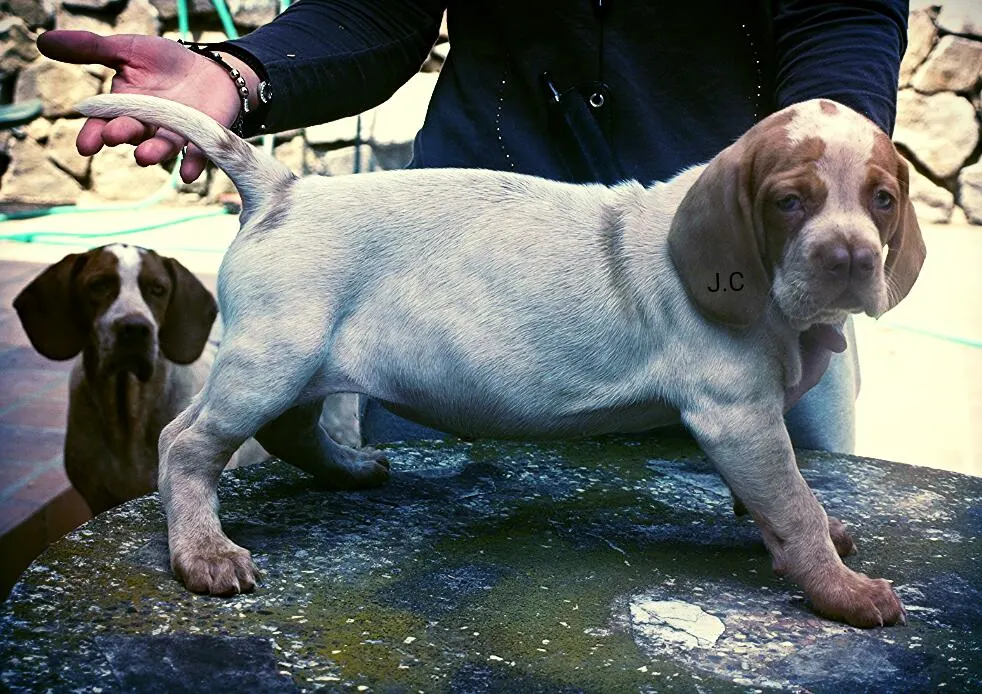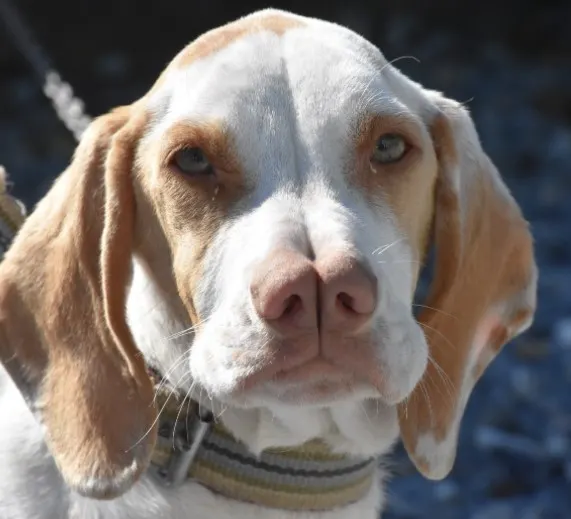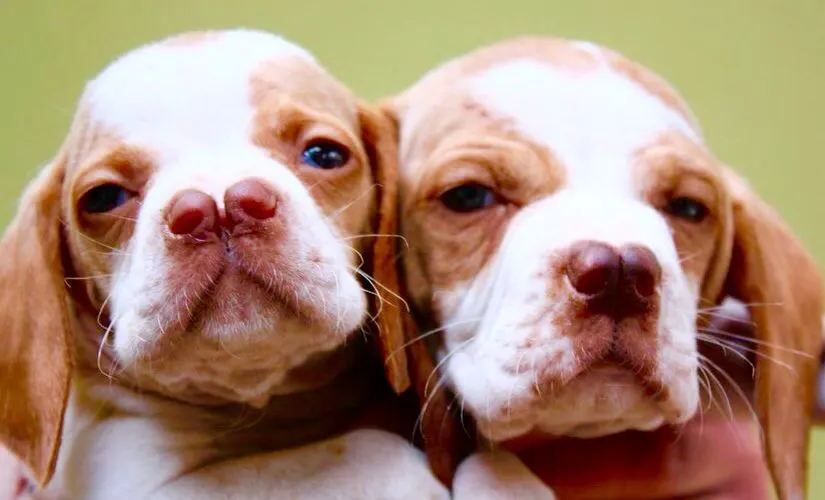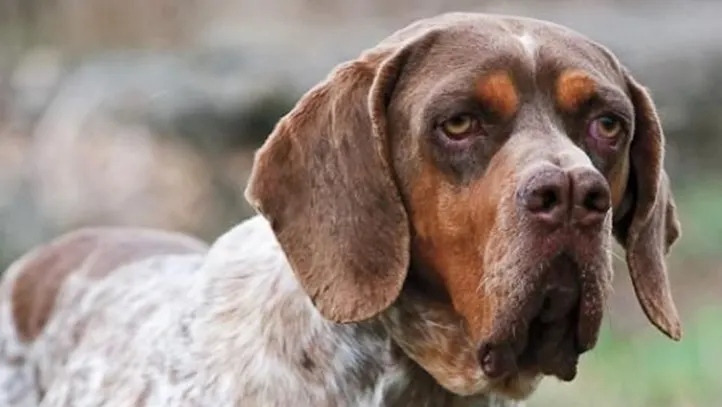One of the rarest physical characteristics in dogs is most certainly the split nose. Also known as a cleft nose, bidfid nose, or double-barreled shotgun nose, a split nose is a feature characterized by the distinct cleft in the middle of the nose separating the two nostrils.
A split nose gives the appearance of the dog having two noses. However, this is only an illusion, since it’s still one nose, just clearly separated by the cleft in the middle.
A split nose is a rare anomaly that can occur in some dog breeds such as Bullmastiffs and Molosser dog breeds. However, there are three rare dog breeds in which the split nose is a common occurrence and even the breed standard.
Meet The Three Split Nose Dog Breeds
As we have already said, these are three rare and distinct dog breeds. This dog’s unique nose enhance their sense of smell and allow them to differentiate between 30,000 to 100,000 different types of smells, whereas humans can only differentiate between 4,000 to 10,000 scents. It’s crucial to maintain the health of a dog’s nose because it’s so sensitive.
Dog nose slits are also quite practical since dogs can jiggle them separately and enhance their smelling abilities.
One breed, Pachón Navarro is located in the region of Navarre in Spain, Europe, Catalburun dog is located in the Tarsus region, Turkey, Asia, while the Andean Tiger Hound is located in Bolivia, South America. However, long distancesbetween the homelands of these three breeds can be deceiving. It’s most likely that these three breeds in fact have one common ancestor.
Pachón Navarro
Pachón Navarro is one of the oldest dog breeds and the most famous one with a “double-barreled shotgun nose.” These dogs have fully divided noses down the center, so much so that it seems they have two noses.
This feature is the result of years and years of selective breeding in the pursuit of developing a dog with a superior sense of smell. For this quintessential hunting dog, as it was proven later, having two noses doesn’t necessarily mean a better sense of smell.

Origin & History
Pachón Navarro originated in the region of Navarre close to the Pyrenees Mountains in Spain. Another name for a Pachón Navarro is Old Spanish Pointer. These big robust dogs are one of the oldest pointer dogs on the Iberian peninsula.
They would accompany the hunters, find the game, stop and point their muzzles toward the pray. This would allow the hunter to prepare and aim at the location of the pray.
Pachóns became extremely popular among the Spanish nobility in the 18th and 19th centuries. However, after the Spanish Civil War, the Pachón numbers dramatically declined. Rabbits were one of the main animals that Pachón hunted. However, their population was devastated by a virus called Myxomatosis. This also severely affected the Pachón population as hunters decided to use other dog breeds for hunt. The situation was so bad that by the early 1970s, it was thought that Pachóns were extinct.
However, Pachón’s situation turned to better at the end of that decade when the Central Canine Society of Madrid created a special Commission for Spanish Breeds in 1978. Commission had the task to find any remaining Pachóns and rejuvenate the breed. Since then, the numbers of Pachón Navarro are steadily climbing. In 2002, an official breed club was formed – The Circle of Hunters and Breeders of Pachón Navarro. Two years later in 2004., the Royal Canine Society of Spain accepted the club’s proposed breed standard and began an official Pachón Navarro registry.
Appearance
Pachón Navarros are medium to large dogs. These are sturdy dogs with strong bodies, heavy legs, straight tails, and drop ears. When looking at the Pachón Navarro you look at the prime example of a pointer-type dog.
Pachóns usually have short, soft, and silky coats. However, some puppies are born with longer coats. The color of the coat is orange, tan, or liver patches on the white background. As we have already said Pachón Navarro is a split nose dogbreed. The split nose is the defining characteristic of the breed and something Pachóns became popular across the world.
Grooming
Pachón Navarros are easy to groom and care for. Generally, a weekly brushing will keep its coat healthy and good-looking. Don’t bathe Pachón often as this can destroy the oily protective layer and cause dry skin.
Personality & Temperament
A typical Pachón Navarro loves the company of the people. These are friendly and even-tempered dogs that are great with other dogs and children. However, don’t get a Pachón if you already own a bird pet. Their instinct is to hunt birds, and it’s simply too strong for them to control it because of their high energy level.
Pachón Navarro is a calm dog that won’t look for trouble. However, if there is a need to defend his owner and himself, he will rise to the challenge.
Health
Since modern Pachón Navarros are offsprings of a relatively small gene pool, they are at risk of inheriting several nasty health issues.
The most common health issues in Pachón Navarro include:
Trainability
Pachón Navarros are intelligent dogs that are willing to please their owners. These traits make them perfect candidates for reward-based training methods. However, they are known to have a mind of their own, so you will need patience and consistency to fully train a Pachón.
Don’t expect to just walk them aroung the dog park for a day. These “double noses” will need much more exercises to be happy.
Exercise
Pachón Navarro is a working, hunting, field dog. Therefore, these dogs need plenty of exercise and physical activity to stay happy and healthy. Owning a Pachón Navarro means providing hours of physical activity on a daily basis often without the leash. Therefore, this is not a dog you want to own if you live in a city or don’t have plenty of free time to dedicate during the day.
Catalburun Dog
Catalburun dog is an extremely rare dog breed. It’s estimated that there are only 200 Catalburun dogs in the world, most of them in Turkey. This is another dog breed that is defined by its split nose. Catalburun’s name derives from the Turkish word “catal” meaning fork and “burun” meaning nose. They also go by breed name “Turkish pointer”

Origin & History
The exact origin of Catalburun is unknown. However, due to the similarity in appearance with Pachón Navarro, it’s thought that Turkish Catalburun originated from Spanish Pachón Navarro. Theory suggests that sometime during the 8th century when the Tarsus region and Spain were both under the rule of the Abbasid-Umayyad dynasty, Pachón Navarro was brought to the Tarsus. The breed established itself across the region and gradually, over time, formed as a separate dog breed.
However, Spanish dog expert Dr. José Manuel Sanz Timón claims that the Turkish Catalburun is an older dog breed that Pachón Navarro descended from. It’s clear these are only speculations and that we will probably never know the true origin of the Catalburun dog, but both of them are amazing hunters.
Appearance
The most famous feature of the Catalburun dog is, obviously, the split nose. These are sturdy, athletic, strong, medium to large-sized dogs. Their frame and posture are that of a typical Pointer dog. Catalburun dog has a long muzzle and a long, straight tail. Catalburun’s coat is short, white, with black, liver, brown, or tan patches.
Grooming
Being a short-coated breed, the Catalburun dog doesn’t need much grooming. Regular weekly brushing will keep the coat healthy and good-looking. However, don’t bathe the Catalburun dog often, as this could strip out the protective oily layer that protects the skin.
Personality & Temperament
Catalburun dogs are calm, quiet dogs that have the potential to become good family pets. They are good with children, and they rarely bark. However, they can become aggressive and territorial towards other dogs and strangers.
These dogs need plenty of space and freedom to feel happy and content to. Therefore, this is not a dog for those who live in apartments. Their energy level is just too high.
Health
Catalburun dog breed is prone to several health issues such as skin allergies, hip dysplasia, and underactive thyroid glands.
Trainability
These are highly intelligent dogs that are willing to please their owners. Therefore, they are ideal candidates for reward-based training methods. A catalburun dog breed is a great option for people interested in agility and other active dog sports.
Exercise
Being a working, field dog, Catalburun needs plenty of exercise and physical activity. To keep them healthy and happy, you need to provide at least two hours of exercise on a daily basis. Failure to do so will result in unwanted behaviors such as chewing, barking, or digging.
Andean Tiger Hound
There is a cloud of mystery surrounding the Andean Tiger Hounds. No one knows the exact origins of these dogs, and for a long time, people thought that they are a myth, a result of an overactive imagination. This is an extremely rare dog breed whose existence was confirmed only recently in the early 21st century.

Origin & History
As we have already said, no one knows the exact origin of the Andean Tiger Hound. However, since this dog breed has a split nose and other characteristics similar to the Spanish Pachón Navarro it’s most likely that ATH descended from this European dog breed.
Pachón Navarro most likely arrived in Bolivia with Spanish conquistadors during their expansion in South America in the 16th century. Over time, the breed developed into the separate breed we now know as Andean Tiger Hound. The interesting part of their name is most certainly the Tiger part. These dogs don’t have stripes, so why are they called Tiger Hounds? Well, their job is actually to track Jaguars. The name for Jaguars in Bolivia is Tigers, thus the name Andean Tiger Hound.
Appearance
There is no official breed standard for Andean Tiger Hound. However, there are still several recognizable characteristics of this dog breed. Generally, ATH should be a medium to a large-sized dog with a strong body and medium-length legs. The muzzle is long and tapering. The coat is short, white, with patches of the liver, black, brown color or it can be tricolored.
Grooming
The coat is short and easy to maintain. However, it tends to shed moderately all the time.
Personality & Temperament
Andean Tiger Hound is a fearless, courageous dog. After all, these are the dogs that hunt jaguars, so they need to be aggressive and have these traits to succeed in this task.
Health
There is no comprehensive information about the health issues of these dogs since they live in remote Bolivian villages. However, one can assume that Andean Tiger Hound puppies will most certainly be prone to be born with a cleft lip and/or cleft palate.
Trainability
Andean Tiger Hound is so rare that there is no real data considering the breed’s trainability.
Exercise
These are working dogs with high prey drive. Therefore, they need plenty of physical activity and mental stimulation to stay happy and healthy.
Conclusion
A split nose is not a common occurrence in dogs. However, in three rare dog breeds, on three different continents, the split nose is fairly common. In fact, the split nose is a breed standard in Spanish Pachón Navarro.
With a few exceptions, many breeds consider bifid noses to be an undesirable trait. For example, in Great Danes, a split nose is considered a disqualification according to the American Kennel Club standard.
Midline anomalies such as clefts have been linked to non-genetic causes. According to Dr. Winston, brachycephalic breeds have a 30% increased risk for these types of defects.

